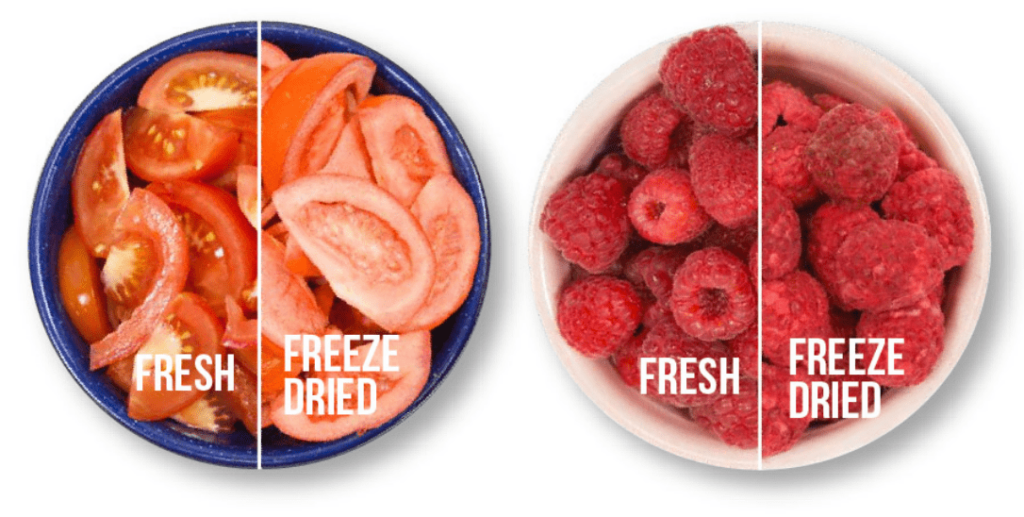
Freeze-dried versus dehydrated food: what's the difference?
There’s a common misconception that the terms “dehydrated food” and “freeze-dried food” are identical, but this is not the case. Knowing the difference is helpful when deciding how to store and preserve food for your family.
History of dried foods
With any type of long-term food preservation, moisture must be removed from the food. Ancient civilizations discovered this and developed the first food drying systems that we still use today.
Dehydration is said to have been practiced since 12,000 BC. The Romans and other Middle Eastern populations dried fruit and vegetables in “drying houses”, using fire to dry and smoke food.
In comparison, freeze-drying is a relatively modern process, first used effectively during the Second World War as a means of preserving blood plasma, medicines and, eventually, food for the troops.
History of freeze-drying
The difference between dehydration and freeze-drying The main aim of food preservation is to remove moisture so that food does not decompose or develop bacteria and mold. Doing so without destroying the food’s basic composition adds both shelf life and nutritional value.
Dehydration in poorly constructed dehydrators eliminates around 70% of the water. In this situation, the food is only good for a few months. Home freeze-drying with Harvest Right eliminates 99% of water. Most homemade dehydrated products, such as dried fruit, meat and vegetables, have a shelf life of one year or less. The same foods preserved in a freeze-dryer have a shelf life of 15 to 25 years.
Comparison table
Lyophilization vs Dehydration
| Criteria | Lyophilization | Dehydration |
|---|---|---|
| Process | Rapid freezing then vacuum sublimation | Water removal by heat |
| Moisture conservation | Removes up to 99% of moisture | Removes 90-95% of moisture |
| Nutrient conservation | Preserves approximately 95% of vitamins and minerals | Retains approximately 60% of nutritional value |
| Appearance and taste | Preserves original shape, color and taste | May alter texture and taste |
| Rehydration | Fast and efficient, restored to near-original condition | Slower, may not fully recover original state |
| Shelf life | Up to age 25 under optimum conditions | Approximately 2 years under optimal conditions |
What’s the best way to preserve food?
Freeze-dried food generally retains 97% of its nutritional value due to the “cold, vacuum” process used to extract the water. Whereas the nutritional value of dehydrated food is generally around 60% of the equivalent fresh food. This loss is largely due to the heat used during dehydration, which breaks down the food’s vitamins and minerals.
An interesting aspect of freeze-drying is that it changes neither the appearance nor the taste of the food. If you freeze-dry a turkey dinner consisting of large slices of turkey, mashed potatoes, gravy, stuffing and corn, when it’s rehydrated and ready to eat, it will taste just as good as if you’d just made dinner. It’s wonderful. And that could be 10 years after freeze-drying the meal.
Another difference is weight. Freeze-dried foods weigh much less than dehydrated foods, making them easier to transport and store. This is particularly important when camping or hiking.
Why choose freeze-drying
Perhaps the best argument in favor of freeze-drying is variety. Almost all foods can be freeze-dried for food preservation and storage. Meat, fruit, vegetables, desserts, even complete meals. And, freeze-dried meals, meats, dairy products, eggs and vegetables rehydrate quickly, sometimes almost instantly.
You can freeze-dry cottage cheese and store it without refrigeration, and sour cream too. Scrambled eggs with cheese? No problem! Freeze-drying is the best way to preserve and store dairy products and eggs. These foods are very difficult to dehydrate.
Freeze-dried foods rehydrate faster and retain their original shape, texture and color. A much wider variety of foods can be freeze-dried than dehydrated.


TASTE
Keep the original flavor, the exceptional freshness and 99% of the natural vitamins.
POLYVALENCE
Optimize storage. Up to 25 years of durability, compact storage and energy savings with freeze-drying

100% NATURAL
No additives. Guaranteed purity and quality for healthy, authentic food
INNOVATION
Revolutionize your kitchen: create unique textures and intensified flavors

ECONOMY
Freeze-dried food at home costs 1/3 the price of store-bought


